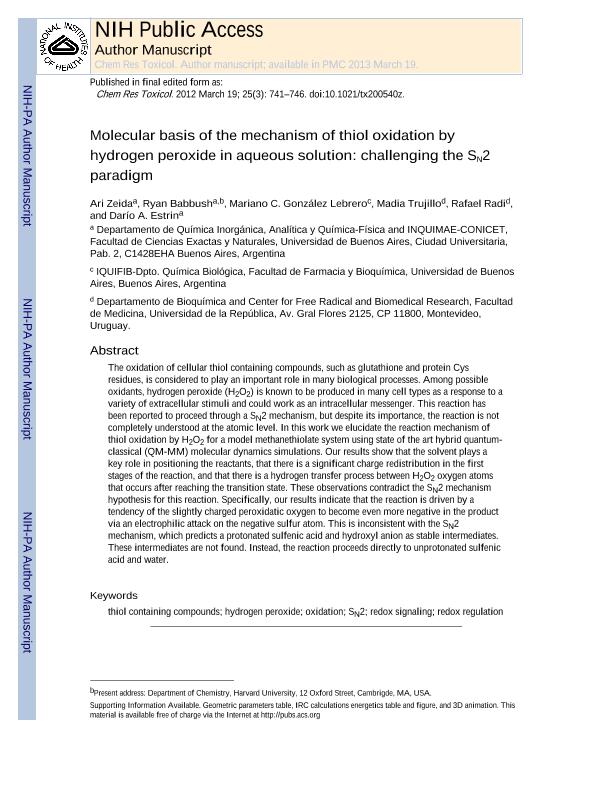Artículo
Molecular basis of the mechanism of thiol oxidation by hydrogen peroxide in aqueous solution: Challenging the SN2 paradigm
Zeida Camacho, Ari Fernando ; Babbush, Ryan; González Lebrero, Mariano Camilo
; Babbush, Ryan; González Lebrero, Mariano Camilo ; Trujillo, Madia; Radi, Rafael; Estrin, Dario Ariel
; Trujillo, Madia; Radi, Rafael; Estrin, Dario Ariel
 ; Babbush, Ryan; González Lebrero, Mariano Camilo
; Babbush, Ryan; González Lebrero, Mariano Camilo ; Trujillo, Madia; Radi, Rafael; Estrin, Dario Ariel
; Trujillo, Madia; Radi, Rafael; Estrin, Dario Ariel
Fecha de publicación:
03/2012
Editorial:
American Chemical Society
Revista:
Chemical Research In Toxicology (Washington)
ISSN:
0893-228X
Idioma:
Inglés
Tipo de recurso:
Artículo publicado
Clasificación temática:
Resumen
The oxidation of cellular thiol-containing compounds, such as glutathione and protein Cys residues, is considered to play an important role in many biological processes. Among possible oxidants, hydrogen peroxide (H 2O 2) is known to be produced in many cell types as a response to a variety of extracellular stimuli and could work as an intracellular messenger. This reaction has been reported to proceed through a S N2 mechanism, but despite its importance, the reaction is not completely understood at the atomic level. In this work, we elucidate the reaction mechanism of thiol oxidation by H 2O 2 for a model methanethiolate system using state of the art hybrid quantum-classical (QM-MM) molecular dynamics simulations. Our results show that the solvent plays a key role in positioning the reactants, that there is a significant charge redistribution in the first stages of the reaction, and that there is a hydrogen transfer process between H 2O 2 oxygen atoms that occurs after reaching the transition state. These observations challenge the S N2 mechanism hypothesis for this reaction. Specifically, our results indicate that the reaction is driven by a tendency of the slightly charged peroxidatic oxygen to become even more negative in the product via an electrophilic attack on the negative sulfur atom. This is inconsistent with the S N2 mechanism, which predicts a protonated sulfenic acid and hydroxyl anion as stable intermediates. These intermediates are not found. Instead, the reaction proceeds directly to unprotonated sulfenic acid and water.
Palabras clave:
Peroxiredoxins
,
Cysteine
,
Computer Simulation
Archivos asociados
Licencia
Identificadores
Colecciones
Articulos(INQUIMAE)
Articulos de INST.D/QUIM FIS D/L MATERIALES MEDIOAMB Y ENERGIA
Articulos de INST.D/QUIM FIS D/L MATERIALES MEDIOAMB Y ENERGIA
Citación
Zeida Camacho, Ari Fernando; Babbush, Ryan; González Lebrero, Mariano Camilo; Trujillo, Madia; Radi, Rafael; et al.; Molecular basis of the mechanism of thiol oxidation by hydrogen peroxide in aqueous solution: Challenging the SN2 paradigm; American Chemical Society; Chemical Research In Toxicology (Washington); 25; 3; 3-2012; 741-746
Compartir
Altmétricas



